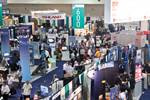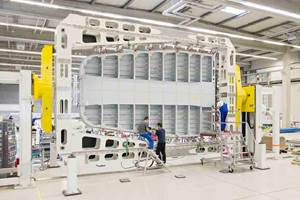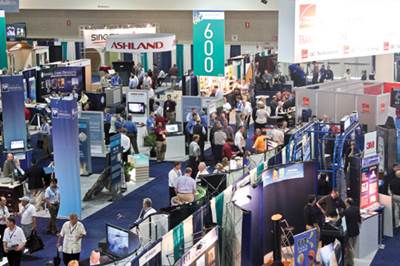Retired U.S. Army general Stanley McChrystal, who until mid-2010 was the commander of the international armed force in Afghanistan, spoke to a standing-room-only crowd at COMPOSITES 2011. His keynote comments centered on leadership and change management.
McChrystal, who now teaches at Yale University, led off with a thank-you to the composites industry, noting the critical protective role composites-based vehicle and personnel armor plays in helping keep American soldiers safe in the Iraq and Afghanistan conflicts. He then shifted to the focus of his speech, which he called “plywood leadership” — the belief that good leadership helps build human systems that are, like plywood (or, for that matter, composites), greater than the sum of their parts. Such leadership, he noted, was lacking in the lead-up to the 9/11 terrorist attacks (“We had the intel to stop the attacks”) and the 2008 financial crisis that triggered the current economic meltdown.
“We’re desperate for leaders in America,” he noted, emphasizing a three-prong leadership strategy that encompasses a keen focus on problems, a willingness to embrace change and the ability to build trust. More concretely, McChrystal believes that good leaders must first identify and actually solve complex problems, implement change and understand how leadership affects other humans.
He illustrated many of his points via anecdotes about his service in the Middle East and, in particular, in Afghanistan, using the histories and cultures of this region to highlight different perspectives on the chronic misunderstandings between the citizens in those regions and American citizens. He noted, for example, that many Afghans believe that they, during their long war with the Soviet Union in the 1980s, effectively fought the Cold War for the West. The Afghanistan that survived the conflict, after millions of its people died and its infrastructure was devastated, has endured more years of internal conflict, massive instability and a complete lack of confidence — all of which, says McChrystal, gives Afghans a predominantly negative view of the U.S. Conversely, he said, America, which funded the war against the Soviet Union, believes it did Afghans a favor. “I argue,” he said, “that you can fly countries into the ground when you lose perspective.”
Although the ability to view problems from more than one perspective is critical and might lead to a change in behavior or problem solving, McChrystal believes the ultimate arbiter of change is the lack of status quo effectiveness. To highlight this, he noted the American tendency at the start of the Iraq conflict to impose on terrorists an organizational structure that mirrors those commonly found the West: a single leader, with several subordinates who have subordinates beneath them, and so on.
What he found in terrorist organizations, however, was a loose network of associations in which neither leadership nor decision making is centralized. Deciding that “it takes a network to defeat a network,” McChrystal reorganized his own command structure to mirror that of the terrorists. In centralized decision making, he said, senior people with access to inadequate information try (and often fail) to make decisions, but he believes that information must be pushed out into the network to the field of action and that soldiers should be empowered to make the decisions.
In their management of people, McChrystal believes strongly that leaders must develop and cultivate relationships. In Afghanistan, he made heavy use of videoconferencing to bring together people in multiple regions for daily field reports. To build trust and engage “teammates,” McChrystal said he made liberal use of one basic question — “What do you think?” — which he believes demonstrates a leader’s ability to listen and see other perspectives. “Relationships require work — honest, earnest, genuine effort,” he said. “Relationships give durability to an organization.”
Related Content
Milliken & Co. partners with MMI Textiles to offer Tegris thermoplastic
The commercial market partnership enables easier access to the Tegris thermoplastic composite fabric for defense customers in the quantities that they require.
Read MoreHypersonix receives CMC scramjet manufacturing demonstrator
HTCMC component demonstrates manufacturing of future Spartan scramjet engine required for reusable hypersonic vehicles capable of up to Mach 12 flight.
Read MoreMATECH C/ZrOC composite is deployed in hypersonic aeroshells
Ultra high-temperature insulating CMC targets hypersonics, space heat shields and other demanding applications, tested up to 2760°C under extreme stagnation pressures.
Read MoreFrom the CW Archives: Airbus A400M cargo door
The inaugural CW From the Archives revisits Sara Black’s 2007 story on out-of-autoclave infusion used to fabricate the massive composite upper cargo door for the Airbus A400M military airlifter.
Read MoreRead Next
COMPOSITES 2011 Product Showcase
Composite Technology magazine's review of the goings-on at COMPOSITES 2011, this year’s edition of the American Composites Manufacturers Assn.’s (ACMA, Arlington, Va.) annual trade show and conference (Feb. 2-4, Greater Ft. Lauderdale Convention Center, Fla.).
Read MorePlant tour: Daher Shap’in TechCenter and composites production plant, Saint-Aignan-de-Grandlieu, France
Co-located R&D and production advance OOA thermosets, thermoplastics, welding, recycling and digital technologies for faster processing and certification of lighter, more sustainable composites.
Read More“Structured air” TPS safeguards composite structures
Powered by an 85% air/15% pure polyimide aerogel, Blueshift’s novel material system protects structures during transient thermal events from -200°C to beyond 2400°C for rockets, battery boxes and more.
Read More

























